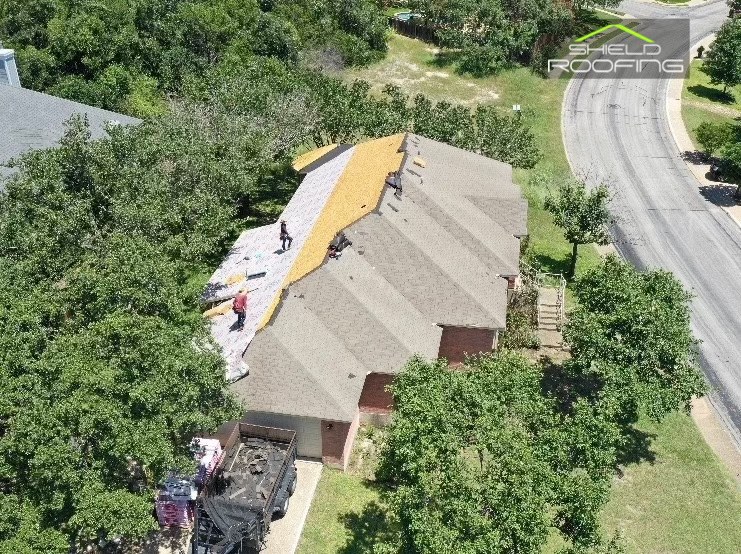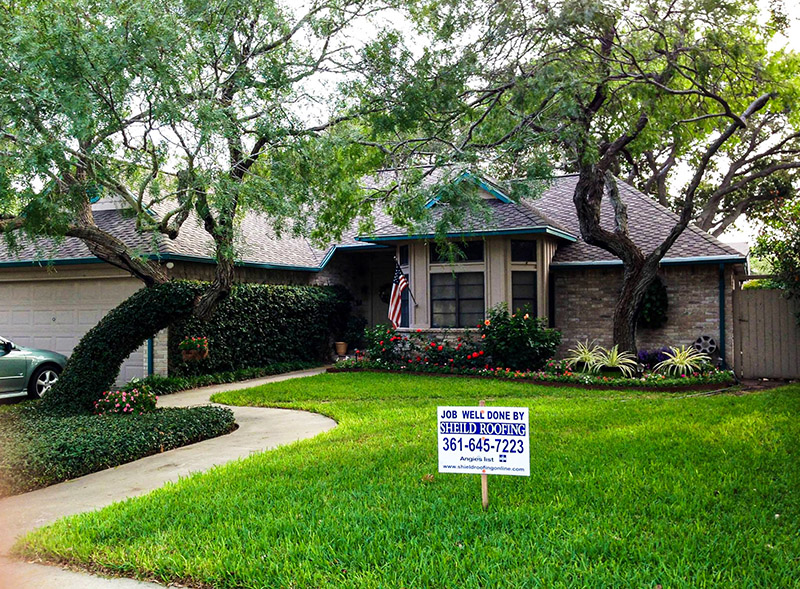Trees can be a wonderful addition to your home’s landscape. They provide shade, beauty and may even increase the value of your property. However, if they grow too close to your roofline, they can cause damage that is both costly and time consuming to repair.
This article will discuss tips for keeping trees away from your home’s roof in order to avoid potential problems. The first step in preventing tree-related damage is understanding how different types of trees affect roofs differently. Knowing which species are more likely to cause harm and why allows you to make informed decisions about which ones should remain at a safe distance from your home’s exterior walls and rooftops.
Understanding How Trees Affect Roofs
Trees near a home’s roof can be beneficial and detrimental; it is important to understand both sides of the equation before proceeding.
Tree root systems are often expansive, which means they have the potential to cause damage to foundations and driveways when close to a house. If trees are positioned too close to a home’s foundation or walls, their roots may grow into cracks in these structures and cause irreparable harm. Furthermore, if planted too close together, tree root systems can also interfere with one another’s growth, leading to stunted development.
Additionally, strong winds from storms can break branches off of trees that are growing too close to roofs and throw them onto the tiles on the roof where they could cause serious structural damage. This wind damage should always be taken into account when planting new trees as even seemingly small branches can become dangerous missiles during stormy weather.
Identifying Problematic Tree Species

Identifying problematic tree species is a key step in keeping trees away from the home’s roof.
When selecting which types of trees to plant, it is important for homeowners to consider how different species may contribute to potential damage and maintenance needs. Choosing species with shallow root systems or small canopies that are less likely to cause issues near the house should be prioritized.
In addition, certain tree species tend to have more aggressive growth habits or produce larger flowers and fruits that can accumulate on shingles and gutters.
For instance, maple trees often send out surface roots while oak trees frequently drop leaves, acorns, and twigs throughout the year. Knowing these characteristics ahead of time helps ensure that any new plants will not pose future threats to the roof’s structure or integrity.
Planning For Tree Growth
When planning to plant a tree near your home’s roof, it is important to consider the size and growth of the tree.
Determining the distance between the tree and your roof can help you ensure that its roots do not cause damage or undermine the structure of your house.
Additionally, choosing an appropriate location for planting is essential as trees require adequate space around them in order to reach their full potential.
Taking into account how big a tree will become when fully grown should be part of deciding where to place it.
If you have limited space available, opt for smaller species so they are less likely to outgrow their spot or come too close for comfort with your home’s rooftop.
When selecting a particular type of tree, research its characteristics and development rate beforehand so that you know what kind of maintenance may be required later on down the line.
Pruning Techniques To Reduce Risk
The art of pruning trees is an effective way to reduce the risk of damage that may be caused by their proximity to your roof. Pruning techniques, when performed correctly and regularly, can help minimize the potential for tree branches being in contact with your home’s roof or structure. Professional advice should always be sought before undertaking any form of pruning as it requires a certain level of expertise and knowledge to perform safely and effectively.
Utilizing these practices will ensure that you are taking all necessary steps to protect your property from potentially costly damages due to overhanging tree branches.
In addition to pruning, there are other approaches you can take such as regular inspection and maintenance around the base of the tree. This includes removing dead branches, trimming back roots if they are encroaching on structures and ensuring that no debris has accumulated beneath the canopy which could cause instability.
Taking proactive measures like this will ensure that you remain vigilant in safeguarding against any potential risks associated with having trees near your home’s roof.
Utilizing Protective Barriers
Pruning techniques can help reduce the risk of trees damaging a home’s roof, but additional steps may be needed to ensure safety.
Installing protective barriers around the area where a tree might come into contact with a roof is an important step for preventing damage. Depending on the species of tree and its size, homeowners should consider installing metal posts or other sturdier materials around the base of the tree in order to provide additional protection from its roots and branches.
When choosing species for planting near roofs it’s also essential to take into account their growth rate and potential height since some trees are far more likely than others to cause harm over time due to their invasive root systems or large branches.
Trees that grow slowly such as evergreens, flowering shrubs, and small ornamental trees are best suited for this purpose as they tend not to require much maintenance while still providing aesthetic value and shade throughout most seasons.
Careful consideration when selecting plantings will ultimately prevent any costly repairs down the line.
Installing Roof Ventilation
The task of keeping trees away from your home’s roof requires both precaution and maintenance. Installing roof ventilation is key to protecting the structure of your house from any potential damage that can be caused by a tree or its branches.
Proper installation will provide an extra layer of protection for your property, allowing you to enjoy peace of mind year-round.
When installing roof ventilation, it’s important to also consider adding insulation in order to prevent heat loss due to air gaps between siding and shingles as well as around windows and doors. This will help keep energy bills low while providing additional protection against adverse weather conditions such as heavy rain or snowfall.
It may also be necessary to repair existing damage caused by fallen branches or wind gusts before the new ventilation system is installed – this should include checking for signs of water infiltration and making sure all joints are properly sealed with caulk or foam sealant.
By following these steps, you can ensure that your home remains safe and secure throughout the life of the tree near your roof.
Regular Inspections And Maintenance
Regular inspections and maintenance of trees that are near a home’s roof is essential for preventing damage to the property. Early detection is key, as it allows homeowners to identify potential problems and address them before they become costly repairs.
Trees should be kept at a safe distance from roofs in order to protect against branches scraping shingles or roots finding their way into gutters. Homeowners should inspect their trees on a regular basis for any signs of overgrowth such as dead wood, damaged limbs, and thick tangles of branches which can all pose risks to the roof.
Additionally, proper pruning techniques must also be employed when trimming back trees so that there is no risk of disease or pest infestation. Pruning should always begin with removing broken or diseased branches first before continuing onto other areas that need attention. If done correctly, pruning will help keep trees healthy while eliminating chances of falling debris damaging the roof below.
Roofs should also be inspected regularly for signs of water damage caused by tree foliage blocking ventilation systems or causing mold growth due to poor drainage. Taking these steps helps ensure that both the roof and nearby trees remain in good condition throughout the year.
Conclusion
It is important to be mindful of the trees near your home’s roof. Different species may grow differently and cause different levels of risk.
Pruning techniques, protective barriers, venting systems, and regular inspections can help reduce the risks associated with having trees too close to a roof.
Proper planning for tree growth should also take place in order to avoid potential damage and costly repairs further down the road.
By taking these steps, homeowners will have peace of mind knowing that their roofs are being protected from any potentially damaging effects caused by nearby trees.

